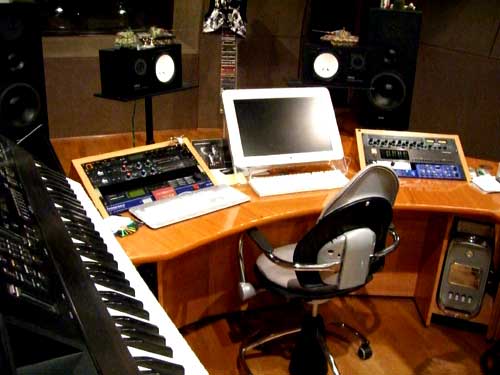Advertisement
Blog Archive
- ► 2021 (1)
- ► 2019 (3)
- ► 2017 (1)
- ► 2016 (7)
- ► 2015 (5)
- ► 2014 (26)
- ▼ 2013 (40)
- ► 2012 (34)
How to assemble a home studio
How to assemble a home studio

Today, a lot of musicians want to have own home studio. And today our topic will focus on the home studio. I think it's pretty cool to have own studio, and to engage their creativity at home - for example make music, rec. your vocal or mix your own music, etc...
Before taking any concrete steps, especially those related to money flow, I always advise not to rush. Sit down and think through carefully and calculate before you buy equipment for studio. But in this article I will try to tell in what direction should not think, not to regret later on wasted time, money, confidence and nerves.
Without exception, all budding musicians and engineers with whom I have to communicate, just dreamed of having his home studio. This desire is natural justifiable and praiseworthy. Of course, I sincerely understand that these people feel. After all, I, too, many years ago had exactly the feeling. However, not all of them can clearly explain what it is they need this studio at home. Even fewer of them could reasonably answer why they need it one way or another instrument, microphone, studio monitor, and not some other..
Why there is such a sad situation? Because people completely ignore the whole theory, guided only by the rule: "Look! my friend has a mega cool studio is such a device, so if I buy myself the same - just start doing hits".
First, let once and for all dispel the myths about magic iron steep western studios which are made solely world hits. Hits are not made of iron, they are made by people, their experiences and knowledge. All the rest - no more than tools.
For example: Many Gobal Stars have a minimum of three engineers who are engaged exclusively on bass guitar. That is 3 people, not just some random person, and upscale professionals with education and experience in this industry, which is fully engaged only bass (from the arrangements to programming MIDI, before the final tracking).
Another example: the no less famous Dr. Dre in an interview once mentioned - "Yes, I often use sampling. If I liked some samples I can use it in my mix. If I need to change something in it - I just call session musicians and they overplayed it so much as I need to do". That is, this people do not just cut some samples with compositions, as it does 90% of the national hip-hop scene, and for himself creates these samples (using professional musicians and arrangers, of course).
So the point, I think, is clear: the main asset of any recording studio - this is not the coolest hi-end iron, tons loaded into racks and good professionals who sit and they rule this iron. Want to make the world hits? - become such a professional, or pay them to do it for you.
Second, you should never forget the sound path, which should be picked up as efficiently as possible, according to objectives and not on the principle: "combined all that was, now I'm mega cool hit maker".
In other words, if your goal - to record vocals and guitar at home, then buying a mixer console with 16 channels will not give you 100 to the hitmaker karma. for example: if you want to record live drums, then buying chic audio intrfeys steep microphones, preamps and converters, and putting it all in the "bare" a room with concrete walls - worthless throughout your setup.
So in what direction we should think and move to bitterly regret not then? To begin with, what you need - a computer with Internet access, google.com, sheet with pen, and, of course, the brain and straight arms.
- Think about it: what is your goal? What do you want to do with the sound? Want-you only record vocals or other instruments? What will these tools - acoustic or electronic? How many? Think about what kind of music you're going to do: for yourself / your friends, family or business with an eye on sales and profits?
- Count "power" of your future studies: how much you need the input / output channels? How many of them will be mono, and how much stereo? How many digital and analog channels you need? How balanced connections and unbalanced? Decide at once: will you have analog or digital mixing? How many channels need preamplification, many devices will be in tears? Choose wisely, think logically - if you have only vocal and guitar, you need a two-channel preamp or two per channel, but not 4 or 8 channels.
- Now is the time to look at it all at right angles - take a pen or pencil and scribble on paper an approximate scheme switching signal in your future studio. Start with the instrument (or singer) as the sound source, and spend it through microphones, preamps, processing devices, routers signals until the last stage - the final media (film, disc or digital release).
- At this stage, you are already fully formed list of equipment and circuit switching. Now, again holding a pencil - arrange all this "wealth" in the room where the plan to record / mixing / mastering, or there is something else. Think about where to stand monitors, where the desktop, where processing units? Where will stand stand with microphones where guitar amps and cabinets? Do not be-acoustic interference, electrostatic, vibration noise, etc. This is a very important step.
- At each your studio, actively use the Internet to find pictures of a device, read its specifications, ask some questions to its owners on the forums.
- If any step imposes adjustments on previous - do not be nervous, as it should be. Start all over again have more than once. back to the 4th leg on the third, and on the third again on the 2nd you will repeatedly. The better and you will unequivocally result.
-
Tags:
- home studio










